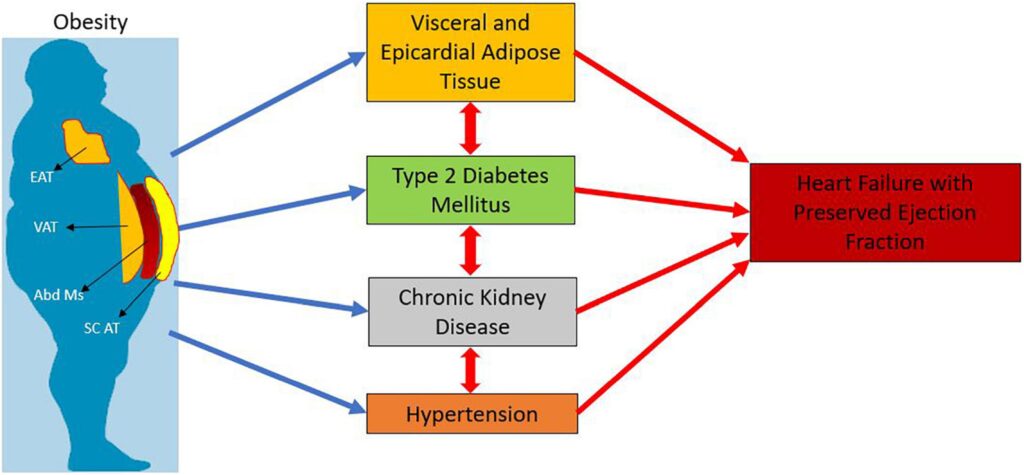Table of Contents
Obesity and Diabetes:
Obesity and diabetes are two of the most significant public health challenges facing the United States today. These conditions not only pose serious risks to individuals’ health and well-being but also place a tremendous burden on healthcare systems. In Orange County, California, these issues are particularly prevalent, reflecting broader national trends. According to the California Health Interview Survey, 24.2% of adults in Orange County are obese, a statistic that underscores the urgency of addressing these intertwined health problems. This article will explore the link between obesity and diabetes, their impact on the residents of Orange County, and the role that healthcare providers like Anaheim Medical Group in Anaheim play in combating these issues.
Understanding Obesity and Diabetes
Obesity and diabetes are closely linked conditions that often coexist and exacerbate each other. To understand the full scope of these health issues, it is important to explore each condition individually and then examine how they intersect.
1. What is Obesity?
Obesity is a condition characterized by an excessive accumulation of body fat. It is commonly measured using the Body Mass Index (BMI), which is a ratio of an individual’s weight to their height. A BMI of 30 or higher is classified as obese. Obesity is not just a cosmetic concern; it is a serious medical condition that increases the risk of various health problems, including heart disease, stroke, certain cancers, and notably, type 2 diabetes.
1.1. Causes of Obesity
Obesity is a multifactorial condition influenced by a combination of genetic, behavioral, environmental, and psychological factors:
- Genetics: Genetic predisposition plays a significant role in obesity. Certain genes may affect how the body stores fat, how it processes food, and how it regulates appetite.
- Diet: High-calorie diets rich in fats, sugars, and processed foods contribute significantly to weight gain. The widespread availability of unhealthy food options and large portion sizes has made it easier for people to consume more calories than they need.
- Physical Inactivity: Sedentary lifestyles, driven by the increasing reliance on technology and decreasing physical activity, contribute to weight gain. Many people do not get the recommended amount of physical activity, which is crucial for maintaining a healthy weight.
- Environment: The environment plays a critical role in shaping behaviors that lead to obesity. This includes access to healthy foods, opportunities for physical activity, and socio-economic factors that influence lifestyle choices.
- Psychological Factors: Stress, depression, and other mental health conditions can lead to overeating and poor dietary choices, further contributing to obesity.

1.2. The Impact of Obesity on Health
Obesity has a profound impact on health and is associated with a range of serious medical conditions:
- Cardiovascular Diseases: Obesity increases the risk of heart disease and stroke by contributing to factors such as high blood pressure, high cholesterol levels, and the development of atherosclerosis.
- Joint Problems: Excess weight puts additional strain on joints, leading to conditions such as osteoarthritis, particularly in the knees and hips.
- Respiratory Issues: Obesity can lead to sleep apnea and other breathing problems, which are linked to higher risks of cardiovascular disease and reduced quality of life.
- Metabolic Syndrome: Obesity is a key component of metabolic syndrome, a cluster of conditions that increase the risk of heart disease, stroke, and diabetes.
2. What is Diabetes?
Diabetes is a chronic condition that affects how the body processes blood sugar (glucose). Glucose is essential for energy, but too much glucose in the blood can lead to serious health problems. There are two main types of diabetes:
- Type 1 Diabetes: This form of diabetes is an autoimmune condition where the body’s immune system attacks the insulin-producing cells in the pancreas. People with type 1 diabetes require insulin injections to manage their blood sugar levels.
- Type 2 Diabetes: Type 2 diabetes is the most common form of diabetes and is closely associated with obesity. In type 2 diabetes, the body becomes resistant to insulin, or the pancreas does not produce enough insulin to maintain normal blood sugar levels. Lifestyle factors, including diet and physical activity, play a significant role in the development of type 2 diabetes.
2.1. Causes of Diabetes
The causes of diabetes are complex and involve a combination of genetic and environmental factors:
- Genetics: A family history of diabetes increases the risk of developing the condition. Specific genetic mutations can also increase susceptibility to both type 1 and type 2 diabetes.
- Obesity: Obesity is the leading risk factor for type 2 diabetes. Excess body fat, particularly abdominal fat, contributes to insulin resistance, where the body’s cells do not respond effectively to insulin.
- Sedentary Lifestyle: Lack of physical activity is a major contributor to the development of type 2 diabetes. Exercise helps regulate blood sugar levels and reduces body fat, lowering the risk of diabetes.
- Diet: A diet high in refined sugars, carbohydrates, and unhealthy fats increases the risk of type 2 diabetes by promoting weight gain and insulin resistance.
- Age and Ethnicity: The risk of type 2 diabetes increases with age, and certain ethnic groups, including African Americans, Hispanics, Native Americans, and Asian Americans, have higher rates of diabetes.

2.2. The Impact of Diabetes on Health
Diabetes is a serious condition that, if not well-managed, can lead to a range of complications:
- Cardiovascular Disease: People with diabetes are at a higher risk of heart disease, stroke, and hypertension. High blood sugar levels damage blood vessels and the nerves that control the heart.
- Kidney Damage: Diabetes is a leading cause of kidney failure, known as diabetic nephropathy. High blood sugar levels over time can damage the kidneys’ filtering system.
- Eye Damage: Diabetes can lead to diabetic retinopathy, a condition caused by damage to the blood vessels of the retina, which can result in blindness.
- Nerve Damage: High blood sugar can damage nerves throughout the body, leading to neuropathy, which causes pain, tingling, or loss of feeling in the hands and feet.
- Foot Problems: Diabetes can cause poor circulation and nerve damage in the feet, leading to foot ulcers, infections, and, in severe cases, amputations.
3. The Link Between Obesity and Diabetes
Obesity and diabetes are closely linked, particularly in the context of type 2 diabetes. The relationship between these two conditions is so strong that the term “diabesity” is often used to describe the interconnection between obesity and diabetes.
3.1. How Obesity Leads to Diabetes
The link between obesity and type 2 diabetes primarily lies in the role of insulin resistance. Here’s how the process works:
- Insulin Resistance: Obesity, particularly excess fat around the abdomen, contributes to insulin resistance. Insulin is a hormone that allows cells to take in glucose from the bloodstream for energy. When the body becomes resistant to insulin, glucose builds up in the blood instead of being absorbed by the cells, leading to high blood sugar levels.
- Beta-Cell Dysfunction: Over time, the pancreas may not be able to produce enough insulin to overcome the body’s insulin resistance. This leads to beta-cell dysfunction, where the insulin-producing cells in the pancreas are damaged, further worsening blood sugar control.
- Inflammation: Obesity is associated with chronic low-grade inflammation, which is believed to contribute to the development of insulin resistance. Fat tissue, particularly visceral fat, releases inflammatory markers that can interfere with the action of insulin.
3.2. The Vicious Cycle
The relationship between obesity and diabetes can create a vicious cycle:
- Weight Gain and Blood Sugar Control: Poor blood sugar control in diabetes can lead to weight gain, as high blood sugar levels contribute to fat storage. In turn, weight gain worsens insulin resistance, making it even harder to control blood sugar levels.
- Inactivity: Obesity often leads to reduced physical activity due to joint pain, fatigue, and other health issues. Lack of exercise further exacerbates weight gain and insulin resistance, perpetuating the cycle.
4. The Prevalence of Obesity and Diabetes in Orange County
Orange County, California, mirrors national trends when it comes to obesity and diabetes. The growing prevalence of these conditions has become a major public health concern, prompting local health authorities and medical providers to take action.
4.1. Obesity Rates in Orange County
According to the California Health Interview Survey, 24.2% of adults in Orange County are classified as obese. This figure reflects a significant portion of the population and indicates that obesity is a widespread issue in the region. Contributing factors include lifestyle choices, socioeconomic status, and environmental influences.
- Lifestyle Factors: The lifestyle of many residents in Orange County, characterized by sedentary behavior and diets high in processed foods, contributes to the high obesity rates. The prevalence of fast food restaurants and limited access to affordable, healthy food options in some areas exacerbates the problem.
- Socioeconomic Factors: Socioeconomic disparities play a significant role in obesity rates. Lower-income communities often face barriers to accessing healthy foods and safe environments for physical activity. These communities may also have limited access to healthcare, which can prevent early intervention and management of obesity.
- Environmental Factors: Urbanization and the design of communities in Orange County have contributed to reduced physical activity. Many neighborhoods are designed for car travel rather than walking or cycling, and access to parks and recreational facilities can be limited.
4.2. Diabetes Prevalence in Orange County
Diabetes, particularly type 2 diabetes, is also prevalent in Orange County. The California Health Interview Survey reports that approximately 9.3% of adults in Orange County have been diagnosed with diabetes. This figure highlights the significant impact of diabetes on the local population and the need for effective management and prevention strategies.
- Demographic Factors: Certain demographic groups in Orange County, including older adults and ethnic minorities, have higher rates of diabetes. This reflects broader national trends and underscores the importance of targeted interventions to address disparities in diabetes prevalence.
- Healthcare Access: Access to healthcare is crucial for the prevention and management of diabetes. In areas where healthcare access is limited, individuals may not receive timely diagnoses or appropriate treatment, leading to worse health outcomes.
5. The Role of Anaheim Medical Group in Addressing Obesity and Diabetes
Anaheim Medical Group, located in Anaheim, CA, plays a vital role in addressing the obesity and diabetes epidemic in Orange County. The healthcare providers at Anaheim Medical Group are committed to offering comprehensive care and support to help patients manage these chronic conditions and improve their overall health.
5.1. Comprehensive Medical Services
Anaheim Medical Group provides a wide range of medical services that are essential for the prevention, diagnosis, and management of obesity and diabetes. These services include:
- Primary Care: Regular check-ups and screenings are crucial for early detection of obesity and diabetes. Primary care providers at Anaheim Medical Group work closely with patients to monitor their health, manage risk factors, and provide personalized treatment plans.
- Specialized Care: For patients with diabetes, access to specialized care is important for managing the condition and preventing complications. Anaheim Medical Group offers endocrinology services to help patients manage their diabetes through medication, lifestyle changes, and regular monitoring.
- Nutritional Counseling: Nutrition plays a critical role in the management of both obesity and diabetes. Anaheim Medical Group provides nutritional counseling services to help patients make healthier food choices, manage their weight, and control their blood sugar levels.
- Physical Activity Programs: Encouraging physical activity is a key component of managing obesity and diabetes. Anaheim Medical Group offers resources and programs to help patients incorporate exercise into their daily routines, which can improve their overall health and reduce the risk of complications.
5.2. Urgent Care and Preventive Services
Anaheim Medical Group also provides urgent care services, which are crucial for patients who need immediate medical attention. For those with diabetes, access to urgent care is particularly important for managing acute issues such as infections, which can be more severe in people with diabetes.
- Covid-19 Testing and Care: During the Covid-19 pandemic, Anaheim Medical Group has played an essential role in providing testing and care for patients. People with obesity and diabetes are at higher risk for severe Covid-19 outcomes, making it critical for them to have access to timely testing and treatment. Anaheim Medical Group’s Covid-19 services ensure that patients receive the care they need to protect their health during the pandemic.
5.3. Patient Education and Support
Education is a key element in managing chronic conditions like obesity and diabetes. Anaheim Medical Group is dedicated to empowering patients through education and support:
- Diabetes Education: Understanding diabetes and how to manage it is essential for preventing complications. Anaheim Medical Group offers diabetes education programs that teach patients how to monitor their blood sugar, manage their diet, and recognize the signs of complications.
- Weight Management Programs: Anaheim Medical Group provides weight management programs designed to help patients achieve and maintain a healthy weight. These programs include counseling, support groups, and personalized plans that address the individual needs of each patient.
- Community Outreach: Anaheim Medical Group is actively involved in community outreach efforts to raise awareness about obesity and diabetes. Through workshops, health fairs, and other community events, the organization educates the public about the importance of healthy lifestyles and regular medical care.
6. Strategies for Preventing and Managing Obesity and Diabetes
Preventing and managing obesity and diabetes requires a multifaceted approach that involves lifestyle changes, medical care, and community support. Here are some strategies that can help individuals reduce their risk and manage these conditions effectively:

6.1. Healthy Eating
Adopting a healthy diet is one of the most important steps individuals can take to prevent and manage obesity and diabetes:
- Balanced Diet: A balanced diet that includes plenty of fruits, vegetables, whole grains, lean proteins, and healthy fats is essential for maintaining a healthy weight and controlling blood sugar levels.
- Portion Control: Paying attention to portion sizes can help prevent overeating and weight gain. Reducing portion sizes, especially for high-calorie foods, can make a significant difference in weight management.
- Limit Sugar and Processed Foods: Reducing the intake of sugary beverages, snacks, and processed foods can help prevent spikes in blood sugar and contribute to weight loss.
6.2. Regular Physical Activity
Regular exercise is crucial for preventing and managing obesity and diabetes:
- Aerobic Exercise: Activities such as walking, running, swimming, and cycling help burn calories, improve cardiovascular health, and enhance insulin sensitivity.
- Strength Training: Building muscle through strength training exercises can increase metabolism, which helps with weight management and improves blood sugar control.
- Incorporating Activity into Daily Life: Finding ways to incorporate more physical activity into daily routines, such as taking the stairs instead of the elevator or walking instead of driving short distances, can help increase overall activity levels.
6.3. Regular Medical Check-ups
Regular medical check-ups are essential for early detection and management of obesity and diabetes:
- Screenings: Regular screenings for blood sugar levels, cholesterol, and blood pressure can help detect risk factors for diabetes and heart disease early on.
- Monitoring: For those already diagnosed with diabetes, regular monitoring of blood sugar levels and follow-up appointments with healthcare providers are crucial for managing the condition.
- Vaccinations: Keeping up with vaccinations, including the flu vaccine and, for those eligible, the Covid-19 vaccine, is important for individuals with obesity and diabetes, as they are at higher risk for complications from infections.
6.4. Mental Health Support
Addressing mental health is also important in managing obesity and diabetes:
- Stress Management: Chronic stress can lead to unhealthy eating behaviors and poor diabetes management. Techniques such as mindfulness, meditation, and therapy can help manage stress.
- Support Groups: Joining support groups for obesity and diabetes can provide individuals with the encouragement and accountability they need to make lasting lifestyle changes.
7. The Future of Obesity and Diabetes in Orange County
Addressing the obesity and diabetes epidemic in Orange County requires ongoing efforts from healthcare providers, community organizations, and individuals. With a comprehensive approach that includes prevention, education, and access to quality healthcare, it is possible to reduce the prevalence of these conditions and improve the health of the community.
7.1. Role of Policy and Public Health Initiatives
Public health initiatives and policies play a crucial role in addressing obesity and diabetes at a population level:
- Healthy Food Access: Policies that increase access to healthy foods, such as incentives for grocery stores in underserved areas and support for farmers’ markets, can help make healthy eating more accessible to all residents.
- Physical Activity Promotion: Creating safe, accessible spaces for physical activity, such as parks and recreational facilities, can encourage more people to engage in regular exercise.
- Healthcare Access: Expanding access to healthcare, including preventive services and chronic disease management programs, is essential for reducing the burden of obesity and diabetes.
7.2. The Role of Technology
Technology is playing an increasingly important role in managing obesity and diabetes:
- Telemedicine: Telemedicine services, like those offered by Anaheim Medical Group, provide patients with convenient access to healthcare providers, allowing for more frequent monitoring and support.
- Health Apps: Mobile apps that track diet, exercise, and blood sugar levels can help individuals manage their health more effectively.
- Wearable Devices: Wearable devices that monitor physical activity, heart rate, and other health metrics can provide valuable insights into an individual’s health and help motivate them to stay active.
Conclusion
Obesity and diabetes are pressing health concerns in Orange County, reflecting national trends that underscore the need for comprehensive prevention and management strategies. With nearly a quarter of adults in the county classified as obese and a significant portion affected by diabetes, addressing these issues is critical for improving public health.
Healthcare providers like Anaheim Medical Group in Anaheim play a vital role in combating these conditions by offering comprehensive care, education, and support to patients. By taking proactive steps to manage their health, individuals can reduce their risk of obesity and diabetes and improve their overall well-being. Together, through collective efforts at the individual, community, and policy levels, we can make strides in overcoming the challenges posed by obesity and diabetes.
Why You Should Visit Anaheim Medical Group:
If you’re in Anaheim and in need of top-notch healthcare, Anaheim Medical Group is your go-to destination. Offering a comprehensive range of medical services, from routine check-ups and urgent care to specialized treatments, Anaheim Medical Group is dedicated to providing exceptional care tailored to your needs.
Their experienced team of healthcare professionals is committed to ensuring you receive personalized, compassionate care in a comfortable environment. Whether you need assistance managing a chronic condition, urgent care services, or COVID-19 testing, Anaheim Medical Group prioritizes your health and well-being, making it a trusted choice for families throughout Orange County.
Company of the Week Shout Out: Cal Vac Environmental
This week, we’re proud to spotlight Cal Vac Environmental, one of the best vacuum truck companies in Orange County. Known for their expertise in industrial cleaning and environmental services, Cal Vac Environmental offers unparalleled solutions for everything from car wash pit cleaning to hazardous waste removal.
Their commitment to safety, reliability, and exceptional service makes them a standout choice for businesses across the region. With a fleet of advanced vacuum trucks and a highly trained team, Cal Vac Environmental ensures that your job is done efficiently and to the highest standards, keeping your operations running smoothly and compliant with environmental regulations.

